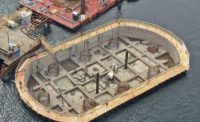Phase IV – Gloucester Remedy Implementation
Best Project, Water/Environment, and Award of Merit, Excellence in Safety
Gloucester, Mass.
Key Players
Owner: National Grid
General Contractor: Charter Contracting Co. LLC
Lead Design Firms: Anchor QEA and GZA GeoEnvironmental Inc.
Construction Manager: GZA GeoEnvironmental Inc.
Subcontractors: Sea and Shore Contracting; Lockwood Remediation; Technologies WSP USA; RPF Environmental; Steele Associates; RL Proulx Electrical; BTT Marine Construction; Cascade Drilling; Semper Diving & Marine; Black Dog Divers; Marguerite Concrete; TG & B Marine Services; Custom Stone Builders; Milinazzo Paving; Accura Construction
Delivering a limited-budget, multi-scope project on a congested historic waterfront would be formidable for any project team. Add in the need to coordinate with four property owners—including the federal government and a city government—and those challenges become downright daunting. “There were so many moving parts in a relatively small footprint,” says Mark Mahoney, principal at Anchor QEA. “It was extremely complicated, plus you had to meet the unique needs of four property owners.”
Over the course of two construction seasons, the project team executed a broad scope of work under difficult circumstances. On the land, the scope included demolition, new construction and reconstruction of historic waterfront structures as well as demolition and deconstruction of an upland park.
In marine areas, work included removal of existing piers and pilings; removal of submerged debris; dredging of impacted sediment; backfill of dredged areas; placement of two sand caps, including one to support 80 marine armor mattresses; replacement of piles and piers for the Gloucester Harbormaster and the Maritime Gloucester Museum; and restored piles on the U.S. Coast Guard Pier.
Throughout the $30-million project, the team had to coordinate with the city of Gloucester, the Maritime Museum and the Coast Guard as well as National Grid, which was the project client that also owned property on the 78,970-sq-ft waterfront area. To avoid the height of tourist season, no work could be performed between Memorial Day and Labor Day. While working during the offseason helped reduce potential interference with other property owners and harbor users, the Coast Guard had to remain 100% operational at all times.
Paul Bertolino, project executive at Charter Contracting Co., says the project was the most complex and sequenced project the company has ever undertaken. “Given the amount of work that had to be done in a short period of time, the amount of coordination required with regard to schedule restrictions can’t be underestimated when you look at a job like this,” he says.
A major portion of the project scope was harbor dredging and removal of soils contaminated by a former manufactured gas plant. Crews excavated and transported more than 42,000 tons of impacted soils and sediments by barge for offsite thermal treatment and disposal. A barge-mounted 200-gallon-per-minute temporary water treatment plant was used to support that effort.
To reduce the risk of odors from dredged materials and to minimize road traffic, Charter transported the equivalent of 1,800 truckloads of contaminated material using thirteen barge loads shipped by tugboat to New Jersey. The strategy eliminated the need to load materials on land, dewater them, stockpile them and process them in downtown Gloucester.
Charter claims that the barging of contaminants for water transport to a disposal facility was a first-of-its-kind method to be implemented in New England.
Crews also placed 80 marine armor mattresses filled with stone and a “sand-organo” clay mix. Charter filled each prefabricated mattress at a staging facility and then trucked four to five 2,000-ton mattresses per trip on a flat-bed trailer to the staging area at the Coast Guard Station. From there, mattresses were placed by a land-based crane with assistance from divers. Additionally, crews constructed and installed a marine pore water cap in the dredge footprint. This reestablished grades, preserved ecological habitats and mitigated migration of waste.
Within the harbor, the team had to preserve historic infrastructure that was surrounded by contamination. That included dredging around the oldest active marine railway in the country as well as the deconstruction and reconstruction of the historic granite seawall.
To maintain the integrity of these historic structures, the team worked with representatives from the Public Archaeology Laboratory who were on site to observe the reconstruction of the seawall and to observe and catalog artifacts unearthed during the diver-assisted suction dredging of sediments around the marine railway.
The project scope also included new construction and reconstruction of seawalls at Solomon Jacobs Park and along the National Grid property. Existing seawalls at neighboring properties were reinforced to improve safety. The new seawall and the addition of accessible land in front of the National Grid building provided enhanced public access to the waterfront. Collectively, the seawalls were re-aligned to better suit the harbormaster’s needs.
The team also replaced the wooden pier in front of Solomon Jacobs Park with a new floating dock system to provide enhanced landing facilities for use by the harbormaster and boaters. Dredging provided additional draft for the harbormaster’s vessel in key areas as well as other recreational vessels operating in the project footprint.
“Overall, we made this piece of the waterfront much more user friendly,” says Kenneth Lento, project manager at National Grid. “It’s a real benefit for the city.”
Judges agreed, noting that the project was not only complex from a logistical standpoint, but also that it was a good addition to the community. “The end product looked great when they were done,” one judge commented.
In the face of many challenges, the project was executed safely. The team established a project-specific air-monitoring program and traffic-control plans. Charter controlled odors by limiting the size of the area disturbed and using foam or other engineered controls, stopping work if necessary. The traffic control plan included route planning for trucks and other vehicles and coordination with local authorities, agencies and the surrounding community on transportation safety issues.
Crews were required to attend and complete multiple marine safety training courses, including monthly man overboard drills and water rescue, boat operator training and on water spill response training. Charter and its subcontractors completed 121,207 work-hours with zero incidents during the course of two construction seasons while working with a 9-ft tidal change.








Post a comment to this article
Report Abusive Comment